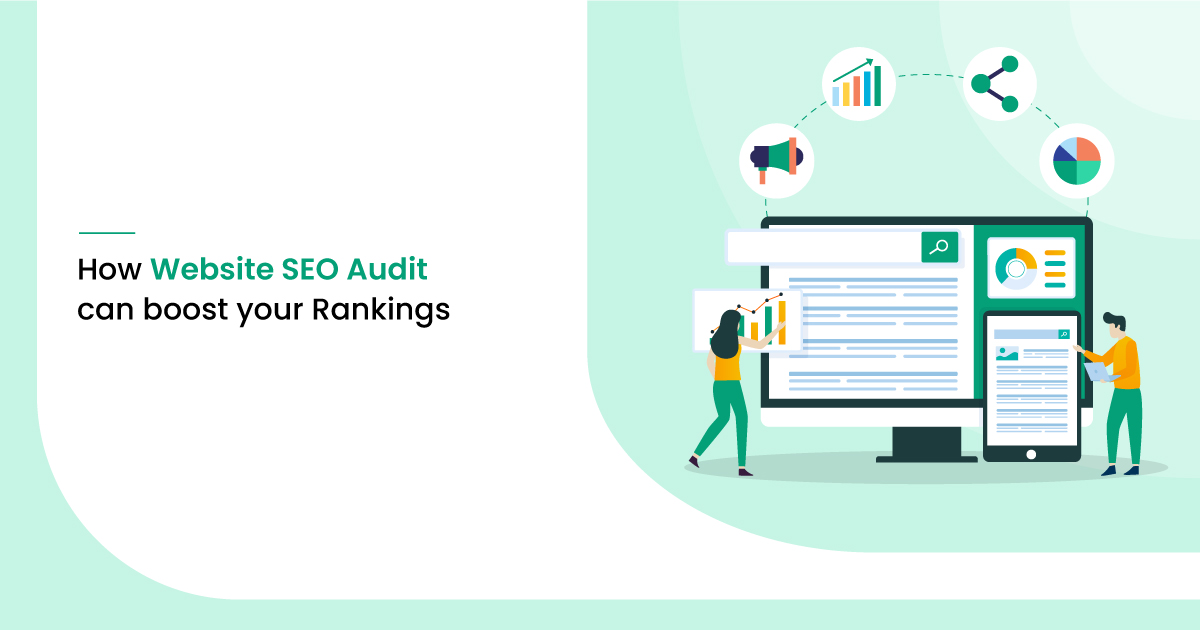Ever found yourself head-scratching in front of your Google Analytics screen, trying to understand why there is a sudden drop in organic search traffic? Or does your website not attract customers? Or maybe your SEO rankings are starting to go down, and you don’t know why? If that’s your case, that could be a good time to do an SEO site audit.
What is an SEO site audit? It is a process of checking certain important components relevant for SEO by a seasoned professional or SEO specialist team. It usually revolves around technical issues, site structure issues, content, link building, and user experience.
Why should you audit your website?
Unless you’re running your business solely through some social media account, normally, your website is the main hub for most of your online presence. If you don’t regularly audit your website for SEO gaps and opportunities, you will inevitably lose organic search traffic. Search engine algorithms are changing constantly and are often difficult to keep up with unless you’re an SEO specialist yourself.
- The website SEO audit will help you check the reliability of your website’s technical structure, assess how optimized it is for search engines, and determine how easy it is for users to navigate and intuitively find content on the website.
- The audit will identify missed SEO opportunities (on-page SEO) and find SEO errors (for example, keyword stuffing, errors in internal linking, and poor content).
- The audit will assess the effectiveness of the website in terms of lead generation and conversions.
What does an SEO site audit consist of?
The following are the components of a complete SEO website analysis
1. Technical audit
This is like running a check-up against potential technical problems – crawl errors, issues with indexing, and hosting.
2. Content analysis
Correctness of the metadata, proper keyword research, content maps, etc.
3. Usability analysis
This one deals with how intuitively understandable the website interface is, how clearly it is designed – are there some wild distracting colors or fonts, is there a breadcrumbs navigation, are lead forms requiring too much info to fill in, etc.
4. Backlink analysis
This is about the quality of external links leading to your website – starting from their sheer number to the linking domains trust and the anchors used.
Tools needed for the SEO audit
SEO professionals use one of these several SEO tools to conduct site audits and control day-to-day work.
1. SE Ranking
SE Ranking is one of the most popular website checkers for an SEO website audit. It includes dozens of parameters and helps you examine your site from different points of view: technical SEO, content, UX, etc. It covers everything related to technical errors (noindex/nofollow, canonicals, redirects, and so on), content issues, usability, internal and external links, as well as image analysis. After the website audit is over, you get a full audit report with all issues and download it to share with your teammates. Actually, it’s one of the best website SEO audit tools with vast functionality that is enough for checking any site.

2. Screaming Frog
Screaming Frog is a well-known site crawler to get technical information on your site performance. It finds broken links and links with redirects and pages with too short, too long, or duplicate title tags and pages where titles are similar to H1 tags. Screaming Frog also shows the information on basic meta tags that Google crawlers assess.

3. Google’s Structured Data Testing Tool
This is a tool to evaluate the structured data markup on your website, allowing you to optimize it. Relevant structured data typically helps to rank in Google and other search engines.

4. Hotjar
Hotjar is a suite of tools used in UX analysis – heatmaps, visitor recording, on-site polls, and surveys. It all helps understand user behaviour, intentions and gets their feedback.

5. GrowthBar
It is a Chrome browser extension that helps conduct keyword research, competitive analysis, and SEO reporting. This tool makes it easy to assess the performance of competing websites and see which traffic channels, keywords, and backlinks are getting results for your competitors.

Technical SEO audit
The first thing you need to do is to run a crawl report for your site. It will help you understand some of the errors on your site. You will see the most glaring technical SEO issues like duplicate content, slow page speed, or missing H1/H2 tags.
You can automate an SEO website audit using various tools and work with the list of errors or warnings generated by the scan. It is a task that you should work on monthly to monitor the site and optimize it effectively. Here are some of the major issues you should pay attention to while doing a technical SEO audit.
1. Page duplication
There could be two or more pages of the same or very similar content on the site. This may happen due to different reasons, starting from a CMS glitch to different content teams working on similar tasks.
If you’re lucky, page duplicates won’t hurt your search ranking but quite often, they really do because search engines “think” that you’re trying to spam with a certain keyword by producing too many similar pages. In this case, the search engine will “punish” your ranking.

Suppose you need to keep several copies of the same or almost identical page for some reason. In that case, you need to tell the search engine crawlers that only one of your pages is actually original by using a “canonical” tag. Another way to deal with page duplication is to merge the content from them.
2. Open/forbidden indexation
Another potential problem that can be related is whether a certain page should be indexed or not. Some pages, like shopping carts, are typically hidden from indexation as they are dynamically generated for each user. There is no point for it to be present in the search engine index. Some other pages, especially those created with certain keywords in mind, are desired to be indexed, but they may not be.
3. Robots.txt file
If you noticed that not all pages are indexed, the first step is to look for the robots.txt file. Sometimes site owners accidentally block search engines from crawling their pages. This makes it mandatory to audit your robots.txt file.
When examining your robots.txt file, you should look for “Disallow: /”. This tells search engines not to crawl a page on your site or even your entire site. Make sure none of your relevant pages has been accidentally blocked by your robots.txt file and that your sitemap is included in the file.
4. Noindex tag
This tag closes the page for indexation. You may not want search engine crawlers to index some pages while you’re working on them or if they contain duplicate content. But if this is an important page, make sure there is a no noindex tag in the <head> section of your page.
5. Canonicals
The rel=canonical tag tells crawlers which of the duplicate pages they should index. However, this tag can be tricky. Make sure that the target page exists and doesn’t contain a noindex robots meta tag. Don’t use the canonical tag in the <body>. You can find more common mistakes in the Google Search Central Blog. Refer to it when checking your technical SEO.
6. Internal links
One of the most common problems with links is broken links. You should delete or fix them in time, as they prevent the flow of link juice. Other common issues are orphaned pages (not linked to any other pages), too many or too few links on one page, deep direct chains, etc.
Title, Descriptions, H1 and H2 tags on each page should be relevant to the specific keyword you’re aiming the page to rank for. Also, they should also be informative, not spammy, and useful for people (help understand what the page is about).
8. Proper formatting
All search engines want to show people the most quality and relevant pages. Relevant use of H2/H3/H4 titles, bulleted lists, numbered lists, and other formatting elements can help a lot with proving that your content is credible and exciting.
9. Text uniqueness
Just copying some text from another competing site won’t work. The search engine will understand that this text is pirated and will downgrade your site ranking accordingly. Even changing some words and paragraphs here and there won’t work. Only original website copy ranks well in search engines.
10. Page load speed
Search engines rank higher fast loading sites, so you need to optimize the page weight. You can check how fast your pages load via multiple tools, including in-browser developer tools and Google PageSpeed Insights. To reduce page weight and speed up page loading, you can compress images and remove unused scripts.

User experience audit
There are many methods to review user experience, including fairly expensive ones, like interviewing actual visitors on the site. There are also some simpler and more obvious steps when doing a UX audit. Here’s what you should look at:
1. Design
- Pop-ups
While in some cases, they may increase conversion, you want to keep them at bay. If the first thing the new visitors see on your site is a full-screen ad, there is a serious probability that they will close the tab. People coming to your site and immediately leaving it increases the bounce rate. - Text illegibility
If your font is too small or too large, it will negatively affect visitors and their behaviour and affect ranking. We want no surprises here. - Clear CTAs/visual cues
People interacting with your site influence your ranking. So making people click on CTAs or other visual cues is very important. Ensure all the buttons and bars are clear, visible, eligible, understandable, and not distracting.
One of the most important things for people on a multi-page site is to understand where they are and how to get to another page. Try to answer the following questions for yourself and adjust the navigation accordingly.
- Is the site navigation clear?
- Is anything cluttering the view?
- Is it easy to “travel” between the most important pages?
In addition, when doing an SEO audit, you may find pages that are not linked with any other sections on your site. You need to make sure that a user can find any page on your resource and get there easily.
3. Mobile-friendliness
If your site is not responsive, you are losing a huge proportion of customers looking for your products or services from their smartphones or tablets. Not to mention that Google has introduced its mobile-first indexing algorithm. So, just make sure that your site is mobile-friendly. You can use a Google tool for that.

4. User behaviour factors
The way users interact with your site is essential. With the help of Google Analytics, you can track the following metrics.
- Bounce rate
A high bounce rate (over 70%) may mean that you are ranked for wrong user intents. Users just enter your site, don’t find what they need, and leave. Or there may be some technical or design issues. - Dwell time
It refers to the length of time a user spends on your site after clicking on it from the SERP and before clicking back. - Engaged time (attention minutes)
It is similar to the dwell time but refers to the time the user interacts with your page and not just leaves it open. A tool named Momently can help you track visitors’ attention. - Interactions
This metric is about downloads, clicks, shares, comments, and other actions. The more efforts made with your page, the higher it is ranked by Google. - Scroll depth
Analyzing the scroll depth helps you better understand if users consider your page useful and interesting. If users don’t scroll down and leave, there’s definitely some trouble with the design or content. Plus, understanding the scroll depth helps choose the best place for CTAs.
Content audit
Suppose you ask yourself what site is interesting to visit and read (on any topic). In that case, you may easily consider that it is a site that is regularly updated, contains high-quality, relevant information, and doesn’t contain misleading or old information. The main indicator of good content is how it engages your visitors. In many ways, engagement metrics overlap with UX. So, here, you once again should look at the session length, scroll depth, number of pages per visit, etc. After you get an impression of the quality and engagement rate of your content, here are the following ways to review your content strategy:
1. The regularity of updates
We live in a fast-paced world, and a lot of information changes degrades, and becomes irrelevant over time. When doing an SEO audit, look at your old pages, posts, guides, and every other form of content and ensure all of them are up to date. Besides, check the regularity of new blog posts – it’s also an important SEO metric.
2. Merging content
When you look at your content with a fresh eye, you may notice that you have two-three articles on the same or nearly the same topic. You may consider merging them into one long-read, which can boost your ranking and also may be quite useful for readers.
3. Deleting content
During an SEO audit, you’ll find pieces of content that are just not useful anymore, outdated, or misleading. Remove them from your site. Otherwise, they will drag down your ranking because of poor behavioural signals from people who somehow still find them.
4. Keyword research & optimization
The key pages of your website should be optimized for specific keywords from your semantic core. One of the things that often slip through is that the semantic core is usually not updated since the early days of your site’s launch. Keep it up to date as new powerful keywords emerge from time to time in every area of interest. In terms of an SEO audit, you can generate reports with all the keywords you already use and new relevant keywords you may use in the future. After you get your keyword report, here’s what you should especially look at.
- Are there any keywords you didn’t optimize your pages for but are ranked for?
- Are there any similarities in pages that rank #1?
- Are there any similarities in pages that do not rank at all?
- What is common between pages that rank #2 and #3?
- Are high-performing keywords in their best places, or is it better to move them to more important pages?
Also, search engines get much smarter, and now mentioning the desired keyword many times across the page is just a keyword stuffing trick from the past. You need to write really meaningful content and include other less popular versions of the same keyword to look more natural and not spammy. When doing an SEO audit, check the keywords density on each page. It should be around 2%. In the picture below, it is clear with the naked eye that the text is stuffed with keywords and can’t be called high-quality text.

Backlink audit
Backlinks are among the most important SEO factors. When somebody posts a link to your site, it gives search engines a signal of credibility – it means that you’ve created a valuable piece of content that others like and share. The more backlinks you get, the more authority your website gets, and a better ranking in search engines will follow. There are a huge number of tools for backlink checking, free and paid. They will provide full information on the following issues,
- Domain trust
- Page trust
- Total number of referring domains
- Number of backlinks
- Top referring domain anchors
- Top backlink anchors, etc.
After performing a backlink audit, follow this simple plan.
- Check out your site’s backlink profile.
- Browse the list of sites that link to you.
- Identify your unnatural/spammy links.
- Remove bad links and set the disallow tag.
- Compare links to your competitors’ ones.
- Start a strategy for building valuable links.
Speaking of unnatural or toxic backlinks, these are backlinks from spammy sites created only for link building, websites with low search engine trust, or objectionable content. Typically, it may happen due to earlier mistakes like buying links or blackhat SEO methods. To remove toxic backlinks, the best way is to contact the website owners and ask them to do that.
Summary
A thorough and regular SEO audit is a mandatory step for any site, regardless of its size and traffic. Even if you think you are doing well with your site, some problems there may be some problems that will soon affect your rankings. Also, thanks to the free website SEO audit, you can find points of further growth. To do this, you don’t even need to hire a third-party specialist or order website SEO audit services from another company.
SEO audit consists of main four areas: the technical audit (crawl errors, indexing, problems with sitemap), content audit (keywords, duplicate, weak, outdated content, etc.), usability audit (mobile-friendliness, page loading speed, user behaviour, design, and navigation issues), and backlink audit (refers to the quality of backlinks, their number, and presence of toxic backlinks).
Once you’ve checked your website for these metrics, collect the data obtained into one report. Then set tasks for improvements – develop on-page SEO, delete duplicate content, change titles and descriptions, and so on—set deadlines for each task and track results during the next website audit.
Now you probably know everything about managing an SEO audit and what to do with its results. So, let’s consider this – when was the last time you ran an SEO site audit?
Need Any Technology Assistance? Call Pursho @ 0731-6725516




